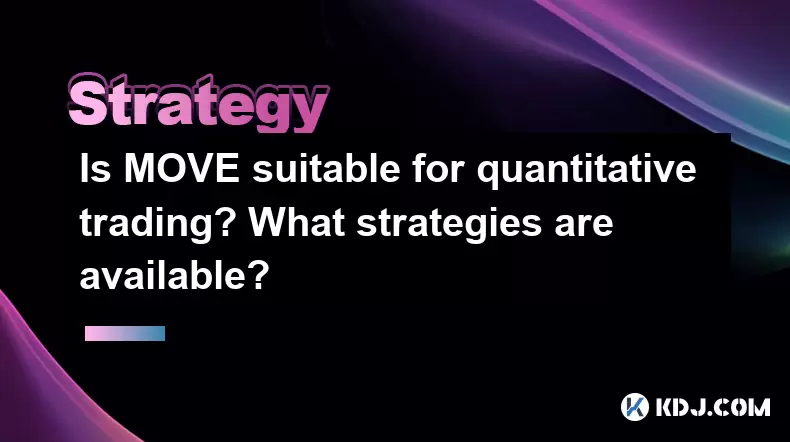-
 bitcoin
bitcoin $121833.232455 USD
-0.63% -
 ethereum
ethereum $4394.437030 USD
-2.00% -
 tether
tether $1.000570 USD
0.04% -
 bnb
bnb $1255.553465 USD
-3.73% -
 xrp
xrp $2.814944 USD
-1.59% -
 solana
solana $221.835346 USD
-2.40% -
 usd-coin
usd-coin $0.999869 USD
0.01% -
 dogecoin
dogecoin $0.249495 USD
-1.32% -
 tron
tron $0.336905 USD
-1.24% -
 cardano
cardano $0.816464 USD
-1.69% -
 chainlink
chainlink $22.130946 USD
-1.27% -
 hyperliquid
hyperliquid $44.208522 USD
-3.46% -
 ethena-usde
ethena-usde $1.000521 USD
0.02% -
 sui
sui $3.422897 USD
-2.51% -
 stellar
stellar $0.380164 USD
-1.31%
Is MOVE suitable for quantitative trading? What strategies are available?
MOVE's safety features make it suitable for quantitative trading, enabling strategies like arbitrage, market making, trend following, and statistical arbitrage.
May 21, 2025 at 12:08 pm

Is MOVE suitable for quantitative trading? What strategies are available?
The world of cryptocurrency trading has evolved significantly, with various programming languages and platforms emerging to support sophisticated trading strategies. Among these, MOVE, a language developed by the team behind the Diem blockchain, has garnered attention for its potential in the realm of quantitative trading. In this article, we will explore whether MOVE is suitable for quantitative trading and delve into the strategies that can be implemented using this language.
Understanding MOVE and Its Features
MOVE is a programming language designed for writing safe and verifiable smart contracts. It was initially developed for the Diem blockchain, which aimed to create a stablecoin ecosystem. MOVE's design focuses on safety, allowing developers to write code that is less prone to common vulnerabilities found in other smart contract languages like Solidity.
One of the key features of MOVE is its resource model, which treats data as resources that must be explicitly managed. This approach helps prevent common issues such as reentrancy attacks, making it an attractive choice for developers looking to build secure financial applications. Additionally, MOVE's linear logic ensures that resources are used in a predictable and verifiable manner, which is crucial for maintaining the integrity of financial transactions.
Suitability for Quantitative Trading
Quantitative trading involves using mathematical models and algorithms to make trading decisions. The suitability of a programming language for quantitative trading depends on several factors, including its performance, ease of use, and the ability to implement complex strategies.
MOVE's strong focus on safety and security makes it an excellent choice for financial applications, including quantitative trading. The language's resource model and linear logic help ensure that transactions are executed correctly and securely, which is paramount in the high-stakes world of trading.
Moreover, MOVE's integration with blockchain technology allows for the creation of decentralized trading platforms. This can be particularly beneficial for quantitative traders who wish to leverage the transparency and immutability of blockchain to execute their strategies.
Implementing Quantitative Trading Strategies with MOVE
To understand how MOVE can be used for quantitative trading, let's explore some common strategies that can be implemented using this language.
Arbitrage Strategies
Arbitrage involves exploiting price differences of the same asset across different markets. MOVE can be used to create smart contracts that automatically detect and execute arbitrage opportunities.
- Identify Price Differences: Write a MOVE function to continuously monitor the prices of an asset across multiple exchanges.
- Execute Trades: Once a profitable opportunity is identified, the smart contract can automatically execute buy and sell orders to capitalize on the price difference.
- Secure Transactions: Use MOVE's resource model to ensure that the transactions are executed securely and the funds are managed correctly.
Market Making Strategies
Market making involves providing liquidity to a market by placing buy and sell orders. MOVE can be used to create smart contracts that manage these orders efficiently.
- Set Bid and Ask Prices: Write a MOVE function to calculate and set bid and ask prices based on market conditions and desired profit margins.
- Automate Order Placement: The smart contract can automatically place orders on the exchange, adjusting them in real-time based on market movements.
- Manage Risk: Use MOVE's safety features to ensure that the smart contract manages risk effectively, such as setting stop-loss orders.
Trend Following Strategies
Trend following involves identifying and following market trends. MOVE can be used to create smart contracts that analyze market data and execute trades based on trend indicators.
- Analyze Market Data: Write a MOVE function to analyze historical price data and identify trends using technical indicators such as moving averages or the Relative Strength Index (RSI).
- Execute Trades: Once a trend is identified, the smart contract can automatically execute buy or sell orders to follow the trend.
- Adjust Strategies: Use MOVE's flexibility to adjust the strategy parameters based on real-time market conditions.
Statistical Arbitrage Strategies
Statistical arbitrage involves using statistical models to identify and exploit price inefficiencies. MOVE can be used to create smart contracts that implement these models and execute trades.
- Build Statistical Models: Write a MOVE function to build statistical models based on historical data, such as pairs trading or mean reversion strategies.
- Monitor Market Conditions: The smart contract can continuously monitor market conditions and calculate the expected returns of different trades.
- Execute Trades: Once a profitable opportunity is identified, the smart contract can automatically execute the trades, ensuring they are done securely and efficiently.
Practical Example: Implementing a Simple Arbitrage Strategy in MOVE
To illustrate how MOVE can be used for quantitative trading, let's walk through a simple arbitrage strategy implementation.
Step-by-Step Guide
- Set Up the Environment: Ensure you have the MOVE development environment set up, including the MOVE compiler and a Diem-compatible blockchain node.
- Write the Smart Contract: Create a new MOVE file named
arbitrage.move.
module Arbitrage {
use Diem::Account;
use Diem::Coin;
struct ArbitrageOrder has key {
source_exchange: address,
target_exchange: address,
asset: address,
amount: u64,
}
public fun init_arbitrage_order(account: &signer, source_exchange: address, target_exchange: address, asset: address, amount: u64) {
move_to(account, ArbitrageOrder {
source_exchange,
target_exchange,
asset,
amount,
});
}
public fun execute_arbitrage(account: &signer) acquires ArbitrageOrder {
let arbitrage_order = borrow_global_mut(Account::address_of(account));
let source_price = get_price(arbitrage_order.source_exchange, arbitrage_order.asset);
let target_price = get_price(arbitrage_order.target_exchange, arbitrage_order.asset);
if (source_price
}
- Compile and Deploy: Compile the MOVE code and deploy it to the Diem blockchain.
- Interact with the Smart Contract: Use the Diem CLI to interact with the smart contract, initializing and executing arbitrage orders.
This example demonstrates how MOVE can be used to create a secure and efficient arbitrage strategy. The smart contract automatically monitors price differences and executes trades when profitable opportunities arise.
FAQs
Q: Can MOVE be used for high-frequency trading?A: Yes, MOVE can be used for high-frequency trading due to its ability to execute transactions quickly and securely. However, the performance of high-frequency trading strategies would also depend on the underlying blockchain's transaction processing speed.
Q: How does MOVE compare to other languages like Solidity for quantitative trading?A: MOVE offers enhanced safety features through its resource model and linear logic, making it more suitable for financial applications compared to Solidity. While Solidity is widely used for Ethereum smart contracts, MOVE's design focuses on preventing common vulnerabilities, which is crucial for quantitative trading.
Q: Are there any limitations to using MOVE for quantitative trading?A: One limitation of using MOVE for quantitative trading is its relatively new status and limited ecosystem compared to more established languages like Solidity. Additionally, the performance of MOVE-based strategies would be tied to the Diem blockchain's capabilities and adoption.
Q: Can MOVE be used to create decentralized exchanges for quantitative trading?A: Yes, MOVE can be used to create decentralized exchanges (DEXs) that support quantitative trading. Its focus on security and safety makes it an ideal choice for building DEXs that can execute complex trading strategies.
Disclaimer:info@kdj.com
The information provided is not trading advice. kdj.com does not assume any responsibility for any investments made based on the information provided in this article. Cryptocurrencies are highly volatile and it is highly recommended that you invest with caution after thorough research!
If you believe that the content used on this website infringes your copyright, please contact us immediately (info@kdj.com) and we will delete it promptly.
- Meme Coins, ETFs, and Crypto Regulations: Navigating the Wild West of Digital Finance
- 2025-10-10 10:25:15
- HYPE, PENGU, and BlockDAG: Decoding Crypto's Latest Moves
- 2025-10-10 10:25:15
- Robinhood, Zora, and the Web3 Creator Revolution: A New York Minute on Tokenized Futures
- 2025-10-10 10:30:01
- Trump, Super Bowl, and Halftime: A Wild 2025 Ride
- 2025-10-10 10:30:01
- Cardano, XRP, and DeFi Integration: A Bombshell Development?
- 2025-10-10 08:25:17
- VeChain's Market Cap Dip: Can VET Stage a Recovery?
- 2025-10-10 10:30:01
Related knowledge

Practical parameter settings for a Bitcoin multi-timeframe moving average system
Sep 18,2025 at 10:54pm
Optimizing Timeframe Combinations for Bitcoin Trading1. Selecting appropriate timeframes is crucial when building a multi-timeframe moving average sys...

How can I filter out false breakouts in Dogecoin high-frequency trading?
Sep 22,2025 at 01:00am
Understanding False Breakouts in Dogecoin Trading1. A false breakout occurs when Dogecoin's price appears to move beyond a defined support or resistan...

Techniques for identifying tops and bottoms in the Bitcoin on-chain NVT model
Sep 20,2025 at 07:54pm
Understanding the NVT Model in Bitcoin Analysis1. The Network Value to Transactions (NVT) ratio is often described as the 'P/E ratio' of the cryptocur...

What does the surge in open interest in Bitcoincoin futures mean?
Sep 20,2025 at 11:18pm
Understanding the Surge in Dogecoin Futures Open Interest1. A surge in open interest within Dogecoin futures indicates a growing number of active cont...

How can I use the Ethereum USDT premium to gauge market sentiment?
Sep 18,2025 at 11:55pm
Understanding the Ethereum USDT Premium1. The Ethereum USDT premium refers to the price difference between USDT (Tether) traded on Ethereum-based plat...

What should I do if Ethereum staking yields decline?
Sep 20,2025 at 06:18am
Understanding the Causes Behind Declining Ethereum Staking Yields1. The Ethereum network transitioned to a proof-of-stake consensus mechanism with the...

Practical parameter settings for a Bitcoin multi-timeframe moving average system
Sep 18,2025 at 10:54pm
Optimizing Timeframe Combinations for Bitcoin Trading1. Selecting appropriate timeframes is crucial when building a multi-timeframe moving average sys...

How can I filter out false breakouts in Dogecoin high-frequency trading?
Sep 22,2025 at 01:00am
Understanding False Breakouts in Dogecoin Trading1. A false breakout occurs when Dogecoin's price appears to move beyond a defined support or resistan...

Techniques for identifying tops and bottoms in the Bitcoin on-chain NVT model
Sep 20,2025 at 07:54pm
Understanding the NVT Model in Bitcoin Analysis1. The Network Value to Transactions (NVT) ratio is often described as the 'P/E ratio' of the cryptocur...

What does the surge in open interest in Bitcoincoin futures mean?
Sep 20,2025 at 11:18pm
Understanding the Surge in Dogecoin Futures Open Interest1. A surge in open interest within Dogecoin futures indicates a growing number of active cont...

How can I use the Ethereum USDT premium to gauge market sentiment?
Sep 18,2025 at 11:55pm
Understanding the Ethereum USDT Premium1. The Ethereum USDT premium refers to the price difference between USDT (Tether) traded on Ethereum-based plat...

What should I do if Ethereum staking yields decline?
Sep 20,2025 at 06:18am
Understanding the Causes Behind Declining Ethereum Staking Yields1. The Ethereum network transitioned to a proof-of-stake consensus mechanism with the...
See all articles

























![Web3 Crypto Market Morning Report: Fomo on the Bnb chain continues, Binance launches the chain-sweeping platform Meme Rush, the market value of Xiuxian exceeds 40 million U.S. dollars, OK Binance business war begins [Vic TALK Issue 1437] Web3 Crypto Market Morning Report: Fomo on the Bnb chain continues, Binance launches the chain-sweeping platform Meme Rush, the market value of Xiuxian exceeds 40 million U.S. dollars, OK Binance business war begins [Vic TALK Issue 1437]](/uploads/2025/10/10/cryptocurrencies-news/videos/web-crypto-market-morning-report-fomo-bnb-chain-continues-binance-launches-chainsweeping-platform-meme-rush-market-xiuxian-exceeds-dollars-binance-business-war-vic-talk-issue/68e861c5dbd1c_image_500_375.webp)
















































